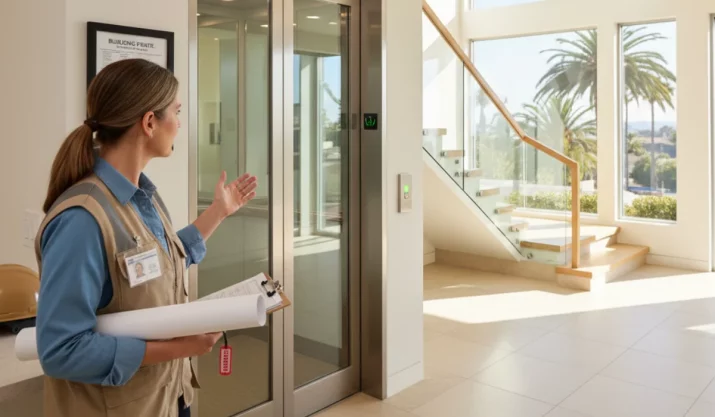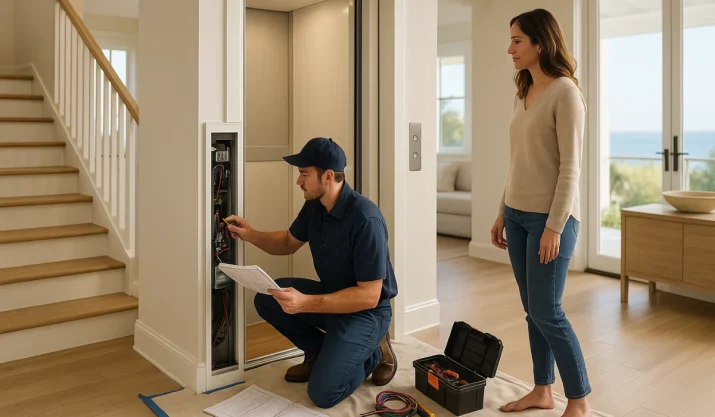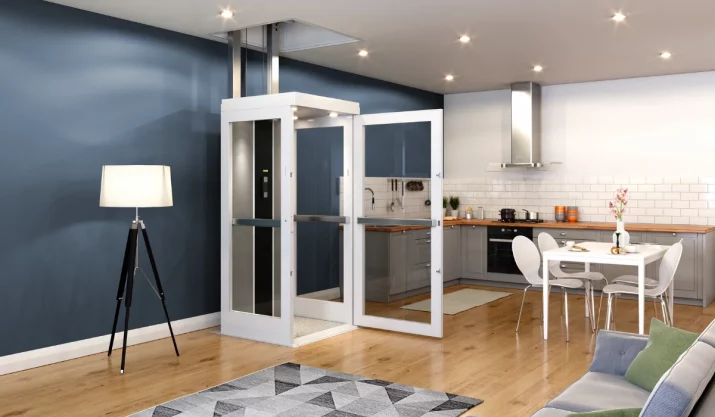Home Elevator Regulations and Permits in San Diego County

Table of Contents
- Key Takeaways
- Understanding Home Elevator Regulations in San Diego
- Permit Applications and Code Compliance
- Safety Standards and Inspection Requirements
- Differences Between San Diego and Other California Cities
- Maintaining Code Compliance After Installation
- Making the Right Home Elevator Choice for Your San Diego Home
- FAQs
A home elevator can make your San Diego home safer and easier to use, especially for older adults and people with limited mobility. Before you start, learn the rules and permits for home elevators in San Diego.
California sets safety and accessibility rules to protect residents, visitors, and contractors. In San Diego County, your project must follow the California Building Code and the California Code of Regulations. These rules set design, construction, and safety requirements for every elevator. Wherever you live in the county, following the steps below helps you avoid delays and extra costs.
This guide explains safety rules, fire code needs, and accessibility basics for home elevators. It also walks you through permits, inspections, and ongoing compliance.
Key Takeaways
- All home elevators in San Diego County must comply with the California Building Code and the California Code of Regulations.
- The City of San Diego requires elevator permits, plan reviews, and safety inspections.
- Safety orders and fire code standards protect residents during installation and operation.
- Working with a licensed elevator service provider simplifies obtaining permits, scheduling inspections, and arranging long-term maintenance.
Understanding Home Elevator Regulations in San Diego
Home elevator projects in San Diego County must meet both state and local standards. The California Department of Industrial Relations (DIR) oversees elevators, escalators, and other lifting devices statewide.
The City of San Diego reviews plans before construction begins. When considering home elevator installation costs in San Diego, remember that compliance with both city and state codes is required. Meeting these standards from the start prevents rework or added fees during inspection.
Elevators must meet ASME A17.1 safety rules. These cover the car, machine room, and emergency communication. California safety orders also set rules for yearly inspections and maintenance. Homeowners must keep their elevators in good working order under these rules.
At California Mobility, we install home elevators that comply with all California building and safety codes from start to finish.
Permit Applications and Code Compliance
One of the essential things you need to know before installing a home elevator is that every home elevator installation in San Diego County requires a formal permit.
Homeowners must file permit applications through their local City of San Diego or county building office before starting work. Each submission includes detailed plans, load capacity information, and a description of the residential building layout.
Your elevator must comply with the California Building Code, fire code, and ADA accessibility guidelines. These rules ensure your elevator car and communication system can safely serve all users, including those with disabilities, as required by the Americans with Disabilities Act (ADA).
Attempting to install or modify DIY home elevators can be unsafe and may violate these standards, posing serious safety risks and leading to failed inspections.
When buying a home elevator in San Diego, make sure your installer is familiar with both state and county permit processes. Working with an experienced installer helps avoid delays during plan review and inspection.
The California Code of Regulations also requires that each elevator unit display a valid operating permit after inspection. Compliance with these safety orders protects homeowners, ensures system reliability, and maintains the property’s long-term value.
At California Mobility, our team of trained and licensed professionals aims to help you meet every technical and legal requirement without stress. We understand San Diego County’s permitting process and California’s building and safety standards, making it easier for homeowners to achieve full compliance while enjoying a safe, dependable home elevator.
Safety Standards and Inspection Requirements
Elevator safety is one of the most essential parts of the installation process. The California Department of Industrial Relations enforces safety orders that define how home elevators, escalators, and related systems must be built and maintained. These include requirements for mechanical design, emergency systems, and regular inspections.
The California Fire Code requires elevators to have appropriate lighting, smoke protection, and an accessible communication system.
Annual inspections check that all parts, including the elevator car, controls, and machine room, meet ASME A17.1 and California Building Code standards.
If you want to choose the best home elevator in San Diego, CA, review the safety features required under these codes. Reviewing them helps confirm your elevator meets regulations and stays reliable over time.
After installation, schedule regular maintenance. A service plan helps you stay compliant, keep the system reliable, and protect your family.
Differences Between San Diego and Other California Cities
While California sets statewide elevator regulations, each city manages its permitting process independently. For example, Los Angeles, San Francisco, and San Jose each have their own review offices and inspection timelines.
In San Diego County, the City of San Diego’s Development Services Department handles most home elevator permits. The city works with the state of California to schedule inspections and verify code compliance.
Some areas within the county may have different fire code interpretations or permit application steps, so it’s best to confirm local details early.
Maintaining Code Compliance After Installation
After the installation, you must maintain ongoing code compliance through regular inspections and elevator maintenance. California Code of Regulations Title 8 requires every elevator unit to undergo a safety inspection at least once per year.
Keep recent inspection records, service contracts, and the operating permit posted inside the elevator. If you remodel or make structural changes that affect the elevator, you may need new permits and inspections.
When choosing the right home elevator company in San Diego, ask how they handle follow-up maintenance and code renewals. A reputable provider helps keep your permits current and your system operating safely.
Following these steps lowers repair costs and extends your elevator’s lifespan.
Making the Right Home Elevator Choice for Your San Diego Home
Knowing the rules and permits in San Diego helps you build a safe, compliant system. Following state and local rules supports accessibility and long-term reliability.
At California Mobility, we help San Diego County homeowners with permits, inspections, and maintenance.
Contact us today or request a free quote. Our team guides your project to ensure it meets California safety and accessibility requirements.








